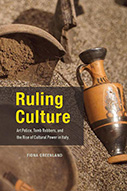Ruling Culture: Art Police, Tomb Robbers, and the Rise of Cultural Power in Italy

Author: Fiona Greenland
Publisher: The University of Chicago Press, 2021. 328 pages.
Reviewer: Neil Brodie
In this thought-provoking book, Fiona Greenland walks us through a couple of centuries of evolving cultural heritage policy in Italy. Central concepts are “cultural power” and “distributed sovereignty.” Italy considers itself, and is viewed by others, as a cultural power. Since 1909, it has enacted a succession of laws designating defined cultural objects (cultural goods) as state property and, therefore, constitutive of Italy as a cultural power. Any theft or loss of cultural objects from state supervision and custodianship erodes Italy’s sovereign integrity and degrades its fabric as a cultural power. Stolen and smuggled cultural objects abroad might be considered as small pieces of Italy that comprise a distributed sovereignty – things to be recovered and reincorporated within the body politic. The Italian response to theft and smuggling has been a longstanding and vigorous campaign to valorize and protect cultural heritage at home and recover smuggled cultural objects from abroad.
An ensuing drama has been played out inside Italy between the state appointed law enforcement agency the Comando Carabinieri Tutela Patrimonio Culturale (TPC) or “art squad,” founded in 1969, and their tenacious adversaries the “tombaroli” or tomb robbers, with the TPC’s jurisdiction envisaged as extending to the sovereign objects abroad. Foucault would have had a field day with this subject matter of classification, surveillance, and control, but Greenland has wisely eschewed what would now be a stereotyped approach. She instead utilises a multi-sited methodology incorporating interviews, literature review, and participant observation to produce a nuanced and multiperspectival account of the issues involved.
Greenland interviewed a few self-confessed tomb robbers but struggled to find any tombaroli. The distinction, it seems, is an important one. Although tombarolo is an Italian term for tomb robber, it carries anti-social connotations of dishonesty and deceit. The tomb robbers she did interview, who rejected any identification as tombarolo, described themselves in more civic or even heroic terms, claiming to have plundered tombs for a sense of adventure or because of an interest in local history and heritage. They were not in it for the money. One is left wondering whether tombaroli actually do exist, or whether they are simply folk devils needed to justify and legitimize the extension of state power through provincial communities, which is indeed one of the book’s contentions. And yet as the book describes, New York’s Metropolitan Museum of Art really did pay $1 million for the so-called Euphronios krater, a sixth-century BC pot dug up the year before from an Etruscan tomb, in 1972. In 2010, the TCP’s Operation Andromeda really did recover more than 300 smuggled antiquities from Switzerland, while Operation Theseus recovered 5,361 smuggled antiquities from Switzerland in 2015. Many similar museum acquisitions and operations could be itemized. Someone, somewhere has been making money and is deserving of the label tombarolo.
In fact, academic reporting of tomb robbing and antiquities theft more generally often sympathizes with the actions and intentions of those interviewed, who, like the Italian tomb robbers, never seem to be the people making money or causing significant damage to cultural heritage. It is always somebody else. Journalists, by way of contrast, do not seem to have any problems rooting out the profiteers. Perhaps it is a question of methodology. Academics tend to engage directly with people doing the digging, while journalists are more likely to start higher in the trading chain and work their way down to source.
But perhaps it is a question too of ethics. Academic research is more tightly constrained by the ethical requirement to protect researchers and their research subjects. In his 2009 book The Lost Chalice, Vernon Silver did manage to locate and interview a tombarolo who had participated in the excavation of the Euphronios krater later sold to the Metropolitan Museum for $1 million (and who had received the equivalent of $8,500 for his efforts). But Silver’s door-stepping methodology would have been energetically proscribed by Greenland’s Institutional Review Board. The book does include a useful appendix describing the methodologies used. Yet there are some general problems here about research ethics and methodologies that the scholarly community needs to properly air and address.
The book offers a ground-breaking discussion of developing Italian policy for cultural heritage, ending with the inevitable neo-liberal entanglements of private capital, but it also contains a wealth of raw material and pointers for further research. The tomb robbers are characterised as an internal other. But clearly during the period under consideration from the late nineteenth century through to the present day, the collecting individuals and institutions of the United States were functioning as an external other, though their voices are relatively muted. It would be interesting to know more about the interplay between the cultural politics of Italy and the United States, and particularly, about how developments in Italy were received and acted upon in the United States – if indeed they were.
Another possible research topic concerns a different type of cultural heritage. The book is ostensibly about Italian cultural objects broadly defined, a category which would include paintings and other artworks, but its focus is upon antiquities and particularly the antiquities of central Italy – the area of ancient Etruria, Latium, and later the Papal States. After the completion of Italian unification in 1871, Italy took all antiquities into state ownership in 1909 to protect them against the market and ongoing haemorrhage for the enrichment of private and public collections abroad, particularly in the United States. But among the constituent polities of what was to become the republic of Italy, a protective interest in cultural heritage can be traced back to the fifteenth century, when measures were enacted in the Papal States to protect archaeological remains. Antiquities were of interest, but so were paintings and other objects of non-ancient art. The famous Florentine decree of 1602, for example, prohibited the export of works by 18 named artists whose loss would be considered detrimental to the adornment and reputation of Florence – this was a seventeenth century prefiguration of the idea of cultural power. Export controls on certain categories of art were regularized by the 1909 law and persist to the present day. There is likely a strand of policy development here parallel to the one isolated by Greenland for antiquities, and while not contradictory, might have generated a different set of tensions and conflicts as the site of cultural power shifted from the conspicuous consumption of wealthy Italian and foreign elites to the valorization and oversight of the Italian state.
Distributed sovereignty is open to more than one response. Recovery and repatriation of stolen and smuggled cultural objects are not the only available actions. During the empire-building years of the first half of the twentieth century, Roman antiquities found outside Italy could be considered sovereign, such as the so-called Venus of Cyrene, which was a Roman statue taken illegally from Libya in 1915 for display in Italy where it served to legitimize Italy’s annexation of Libya as historical Roman territory. Mussolini went one step further. The archaeological sites of the Roman empire comprised a distributed sovereignty that invited territorial, rather than material, recovery.
Although the events of this imperial interregnum are to some extent diversionary from the book’s main narrative, they do offer the opportunity for some insightful scholarship. In Chapter 3, Greenland brings her art historical eye to bear on a 1935 newspaper cover image of Mussolini for an exacting dissection of its iconography. In Chapter 5, in 2008 when the Venus of Cyrene was returned to Libya at a meeting in a tent in Benghazi between Muammar Qaddafi and Silvio Berlusconi, Berlusconi was quoted as saying “Muammar, I brought your girlfriend back.” In what follows, she provides a coruscating explication of the cultural and political contexts of this one single quip. Wonderful stuff.
Neil Brodie is an Endangered Archaeology in the Middle East & North Africa (EAMENA) Project Senior Research Fellow at the University of Oxford School of Archaeology.


